repository for research into the social and material contexts of historical dress, specifically my own costumes. This blog is trans-affirming.
Don't wanna be here? Send us removal request.
Text
Dating a Jacket, Part 1
The Eighteenth-Century Assumption
Part 2 here
Sometimes you come across a piece of clothing and the date just seems a little too ambiguous. That was the case with this jacket, number 1981.314.2, held by the Metropolitan Museum of Art, which is said to be from the 2nd quarter of the 18th century. The good people at the Costume Institute within the Met were kind enough to take detailed photos of the jacket for me, including details of construction. These images were invaluable in allowing me to create my own version, but have also given me some questions about their chosen date. I am not allowed to share the images they took for me without express permission, so if necessary I will include photos from my own jacket.
First, let us remind ourselves of what the jacket looks like:


Left: jacket, Italian, 1981.314.2. Dated 2nd quarter 18th c. Metropolitan Museum of Art. Right: my own recreation of the same jacket.
The Met gives the original jacket a moderately wide date range of 2nd quarter of the 18th century, so between 1725 and 1750. And I can see what influenced them to make that decision. At first glance, the overall shape has strong similarities with the examples below of wide-necked riding jackets.


Left: Casaquin, textile 1710-1720, garment 1720-1730. Right: Casaquin, c. 1730-1740. Both from Palais Galliera


Left: Agnieszka Emercjanna Pociej ascribed to Ádám Mányoki, before 1722. Right: Lucy Pelham-Holles by Godfrey Kneller, 1722.


Left: Sophie Marie von Voss by Antoine Pesne, 1746-1751. Right: Maria-Antonia von Fürstenberg by Franz Josef Weiss, 1758.
Please note, however, that regional fashion changes do exist and none of the examples are Italian. I could not find any images of similar jackets from Italy. If anyone does have images of riding habits/jackets from Italy in the first half of the 18th century, I'd love to see them! However, these images do show at least a moderate geographic distribution of this trend: France, Germany (Prussia and Swabia), England, and Poland. All of the examples feature a wider neckline than the close-to-the-neck style found in men's coats and in some other women's riding jackets, and also feature metallic trim embellishing the front and cuffs. So far, so good, right? Well--let's dig deeper.
First, what do I mean by "riding jacket?" I am using the phrase to denote these and other women’s jackets from the 17th and 18th century that are inspired by menswear and originally used for the purpose of riding and hunting. Some of you may be more familiar with the term "riding habit" in which the jacket is worn with a matching petticoat and maybe a waistcoat to create a complete outfit.
Many of these jackets have trends directly borrowed from menswear like pockets and button-fronts, and fasten at the center front without a stomacher. However, as riding jackets and riding habits became an acceptable part of fashionable dress, some of these characteristics may have been adapted, or vanished almost entirely, as is the case with the two French casaquins seen above. These jackets represent the way that practical garments adapted to fashionable tastes. You can see Mme Gaspard de Peleran wearing a very similar jacket in this sketch by Liotard–its equestrian nature is denoted by the long riding whip she holds in her hand.

Madame Gaspard de Péleran by Jean-Etienne Liotard, est 1738-1742 (my estimate is based on Liotard's residence in Turkey from 1738 to 1742, where the subject's husband was French Consul in Smyrna)
So where do my doubts about the Met's jacket come from? Well, it's mainly the construction. When we look at extant riding jackets, however, the vast majority of the (admittedly few) originals have front waist seams, something absent from my own. The brocade casaquin above? waist seam. The pink casaquin? can't say, hidden by lace, could be either. This 1730-1750 riding jacket from the Snowshill Wade Costume collection was even patterned in Janet Arnold's Patterns of Fashion Volume 1, pp 24-25, so you can really see the waist seam:


Whether plain or ornate, you'll probably find a waist seam!


Left: Riding Jacket, 1740s, John Bright Collection. Right: Riding Coat, 1750-1759, V&A Museum.
I found exactly one riding jacket which clearly does not have a front waist seam, and it's from very early in the period:

Jacket, 1710-1725, Palais Galliera.
If we look at paintings, we do find a few more examples that seemingly don't have a waist seam. Some of these might be artistic license or simply the artist not wanting to paint every single seam, but I'm inclined to believe at least some of them, like this painting by Nicholas Lancret:

Picnic After the Hunt (detail) by Nicolas Lancret, 1735-1740, National Gallery of Art.
Why do I trust it? The waist wrinkles. Ask me how I know...

Okay, so, a waist seam of lack thereof isn't proof one or the other about dating. But there are other oddities of construction as well. For instance, looking at this picture of my own jacket, do you see the pocket? These pockets have no flap and are cut straight across, whereas every other example I've shown so far has a pocket flap. This is much more in keeping with men's coats from the same period:


Left: Coat, British, 1720s, Met Costume Institute. Right: Coat, German, 1720s-1730s, LACMA.
Also, where are the rest of the buttons? The jacket held by the Met has 100 buttons total--33 along the front, 8 along each pocket, and 17 along the side and back vents. These men's coats, the most button-heavy of all the examples shown here, have buttons along the fronts, below the pocket flaps, and along the top cuffs, but none running along the vents:


In addition, the Met jacket has large contrasting cuffs, which does not seem to be as much an element of jackets from the 2nd quarter of the 18th century, unless it matched a waistcoat.



Top: Le Repas au retour de la chasse (detail) by Nicolas Lancret, c. 1725. Bottom Left: Anna Katarzyna Orzelska by Louis de Silvestre, c.1730. (red waistcoat matching cuffs is just visible at front opening below lace). Bottom Right: Coat, c. 1735, National Museums Scotland.
None of these cuffs have a heavy trim around the edge though, like the pleated pink ribbon and silver braid on the Met's jacket. It is possible that the cuffs and trim are a later addition, but just comparing the braid on the cuffs to the braid on the rest of the jacket, they appear to be the same 4-strand silver metallic braid.


While this does not rule out the possibility that they were an addition made at a different time, it does make it, in my opinion, most likely that the cuffs are contemporary to the rest of the jacket. In addition, most cuffs of 1725-1750 jackets and coats are cut separately to the sleeve and then attached, whereas the cuffs of my jacket are cut in one with the sleeve and folded back.
So where does that leave us? Well, the Met appears to be correct in noticing that wide-necked riding jackets are largely a phenomenon of the early-to-mid 18th century. The large turned-back cuffs and lack of a waist seam would probably push this earlier in their proposed date range, closer to the 1720s than the 1750s. In my next post, however, I will introduce another possibility--what if the jacket is earlier? Maybe even much earlier?
Part 2
Additional Resources:
Images of more riding jackets found at the 18th Century Notebook from Larsdatter
@vincentbriggs has detailed posts on 1730s coat construction here and here, and in general is a font of knowledge for 18th-century tailoring.
jeannedepompadour.blogspot.com has a good collection of images of early 18th-century riding jackets.
Janet Arnold, Patterns of Fashion vol 1. Originally Published 1972, reissued 2021 by School of Historical Dress.
17 notes
·
View notes
Text
Dating the Jacket Part 2
The Case for the 17th Century
Part 1 here.
In Part 1, I compared my riding jacket to some early/mid-18th century examples, contemporary to the time which the Met Costume Institute gives for the original. I appreciate how the Met came to this decision, but while getting close-up experience constructing my own, I began having questions about that date range. In this part, I will show some strong similarities it shares with earlier styles of the 1670s and 1680s. First, a reminder of the jacket in question:

Jacket, Italian, 1981.314.2. dated 2nd quarter 18th c. Metropolitan Museum of Art.
Here are some of the characteristics of the jacket that it has in common with jackets from the 1670s-1680s.
unpleated skirts
close-set buttons down the length of back and side vents
"hounds-ear" turned back cuff cut in one with sleeve
narrow, horizontal pockets
contrasting cuffs
There is a large caveat, however, that none of the examples I have seen show a wide neckline. Most necklines are either obviously cut close to the neck or are obscured by hair and cravats, but are still almost certainly cut to the neck given that the role of cravats is to hold the neck of a shirt closed. "Floating cravats" aren't really a thing here.
So I suppose the question I'm asking here is: are the other details of decoration and construction I'm explaining here persuasive enough to overcome other factors, like the neckline and the Met's own dating? Let's begin!
Here's the painting I saw that really made me think "wait...am I onto something?"

Mary of Modena by Simon Verelst, c. 1675.
This isn't an isolated incident either, as you can see from the two images below--one of them actually from Italy!


Left: Elisabeth Charlotte of the Palatinate by Louis Ferdinand Elle the Younger, c. 1675. Right: Noblewoman attributed to Pierfrancesco Cittadini, before 1681.
These three women are wearing a version of the justaucorps, which emerged as part of men's fashion in the 1660s, eventually replacing the doublet. Since women's riding jackets of this period were so closely modeled on men's, I think it makes sense to look to men's jackets for information on style and construction, especially since, to the best of my knowledge, there are no extant women's riding jackets for me to access and compare.
In this early version of a justaucorps, you can see some of the shared features with my jacket: numerous buttons along the front, side, and back vents, narrow horizontal pockets, and unpleated skirts:


Man's coat, 1660-1675, Palais Galliera
Here is what Norah Waugh had to say in The Cut of Men's Clothes, 1600-1900:
During the 1670's and 80's the coat acquired a straighter and more elegant line by being more shaped on the underarm and centre back seams. The sleeves also became more fitting and reached just below the elbow with long narrow cuffs--'hounds' ears' cuffs. The early habit of adding a variety of trimmings and accessories lingered on and they were an essential part of the design of these early simply-cut coats. (Waugh, 52)
She further adds that in in the 1690s cuffs and sleeves began getting cut seperately, and skirts started being pleated around the start of the 18th century. To illustrate this point, here is a comparison of the diagrams she made for a 1681 coat compared to a 1720s coat--the period in which the Met partially dates their jacket.


Left: page 59, diagram XV. Right: page 64, diagram XVIII. Both in Waugh, Cut of Men's Clothes, 1964.
In addition to the changes mentioned above, you also see the disappearance of the side-vent buttons and buttonholes, buttons being spaced further appart, and a larger, shaped pocket flap. Speaking of pockets...

The Met's jacket has pockets that I haven' really seen anywhere else. A slit was cut in the fashion fabric and then the raw edges were bound with that same fabric. There were only 2 buttonholes, one on each end of the pocket slit. I recreated this faithfully in my reproduction. This is something I haven't been able to find in any 18th-century jackets, and even in the 17th century you see narrow rectangular flaps as often if not more frequently. Below are two pockets with similar elements to my own. On the left, this coat appears to be cut without a pocket flap and the edges left raw, since it's made of a high-quality, non-fraying wool, and all the buttons are functional. On the right, we have a pocket with a narrow flap, and only the first and last buttons are fastened in the buttonholes.


Left: Wedding Suit of James II, 1673. Right: Wedding Suit of Sir Thomas Isham, 1680. Both in V&A.
side note--look at how narrowly the buttons are spaced--a much more similar arrangement to my own jacket than examples from the early/mid 18th century.
And then there are the cuffs. In part one, I observed that the large jacket cuffs in the 2nd quarter of the 18th century tended to be of the same fabric of the jacket, or match an accompanying waistcoat. In the period 1670-1680 however, you are much more likely to see cuffs that contrast strongly. This can be seen in the portraits of Mary of Modena and Elisabeth-Charlotte of the Palatinate above, and the painting of men from the Tuscan court of Ferdinando de'Medici

Portrait of Three Musicians of the Medici Court by Anton Domenico Gabbiani, c. 1687.
The two figures in the foreground both have strongly contrasting brocade cuffs, much like the cuffs of my own jackets. However, they do not have applied decoration around the cuff edges. That doesn't mean that ornate trim, like pleated ribbons and silver braid didn't happen. For one, Elisabeth-Charlotte has floppy gold and silver lace trimming her cuffs, and for another, we've got ANOTHER Italian gentleman below:

Carlo Borromeo Arese by unidentified artist, 1674.
It's a lot of look but he seems happy about it.
As an added bonus, the brocade ribbons in his portrait remind me of the ribbons on the Met jacket too!

So, on the strength of this evidence, if I were to propose another date for the jacket at the Met, I would suggest the 1670s-1680s. Keep in mind though, I am not an expert, and I also acknowledge that dating may be challenging considering how Italy was fragmented into different kingdoms at the time. Trends in Naples would act differently than in Venice, Tuscany, etc., and regional fashions Are a Thing. So much English-language research, the research that I can access, is focused on fashions from England and France, meaning that variations in other parts of Europe can go unrecognized. I do not want to wholly discount the possibility that some trends lingered longer in some parts of Italy. However, I think that there are very definite similarities in style and construction between this jacket and other examples from the 1670s and 1680s.
So--is that it? Have I successfully made the case for an earlier dating of the jacket? Well...maybe? Ultimately without more information about the jacket's history, information that may well be lost forever, we cannot say for certian. And the neckline is still a bit of a puzzle. In all the examples of 17th-century women's riding jackets I found, they all had the usual high neck. Here are the options as I see them:
The Met is correct, this jacket was made up sometime between 1725 and 1750
This jacket is entirely a product of the 1670s-1680s, and reflects either a heretofore unnoticed trend or just one woman's own idiosyncratic tastes
This is a 1670s-80s jacket that was later altered, perhaps in the 2nd quarter of the 18th century in response to trends for wide-necked riding jackets. The silver lace trimming the jacket neckline doesn't appear elsewhereon the jacket, so it could possibly be a later addition
Split the difference...it's from the 1700s/1710s! Except fashion isn't really like math where you just find the average between to points and it's the answer. But, I suppose it is possible that there was a tailor somewhere still working off of older patterns who adapted to later tastes.
It's entirely a fantasy of a later date, like some 19th century nonsense. The details of the jacket like the numerous passementerie silver buttons (which are extremely fiddly and annoying to make and time-consuming...ask me how I know), and the overall cut of the jacket with seems clearly cut to fit over stays, read as sufficiently authentic to me, but it's worth acknowledging that this is an option, just not the likeliest one.
Given the details of cut and construction, I am most inclined to options 2 or 3. But of course, this is all my non-professional opinion. I hope, however, these posts show how historical costuming and clothing reconstruction can be used to promote deeper understanding of original garments, and encourage the sort of questions that lead to deeper research.
Additional Resources:
FIT's Fashion History Timeline has good overviews of trends:
1660-1669
1670-1679
1680-1689
jeannedepompadour.blogspot.com has a good collection of images of riding habits.
Norah Waugh's The Cut of Men's Clothes, 1600-1900 (Faber and Faber, 1964) can be found in various places.
11 notes
·
View notes
Text
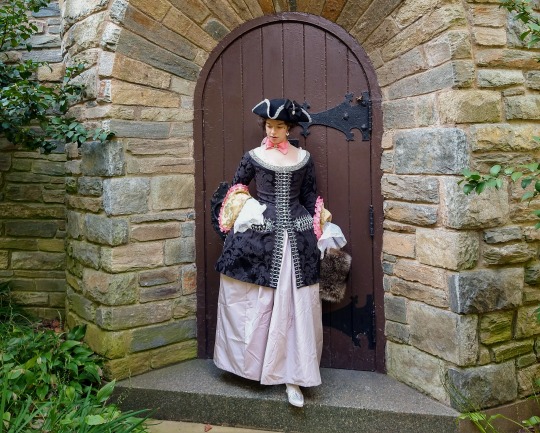
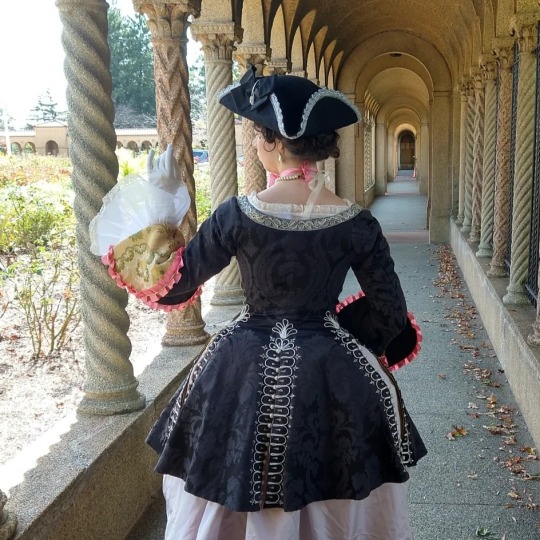
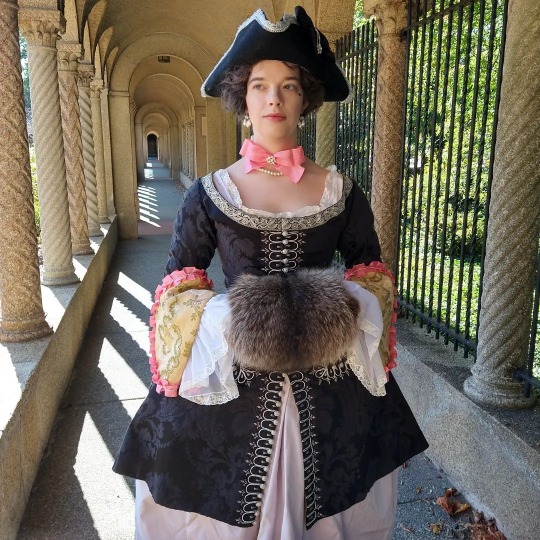
This jacket is the result of more than 2 and a half years of work, entirely handsewn! It represents the interest in equestrian and equestrian-inspired clothing as fashionable attire in Europe during the late 17th and into the 18th centuries.
I copied it from a jacket held by the Met Costume Institute, accession number 1981.314.2. When I emailed out to them for more information about the jacket, one of the collections people was even kind enough to pull it out of storage and take some detailed shots of the exterior AND interior (thanks Marci!!!)
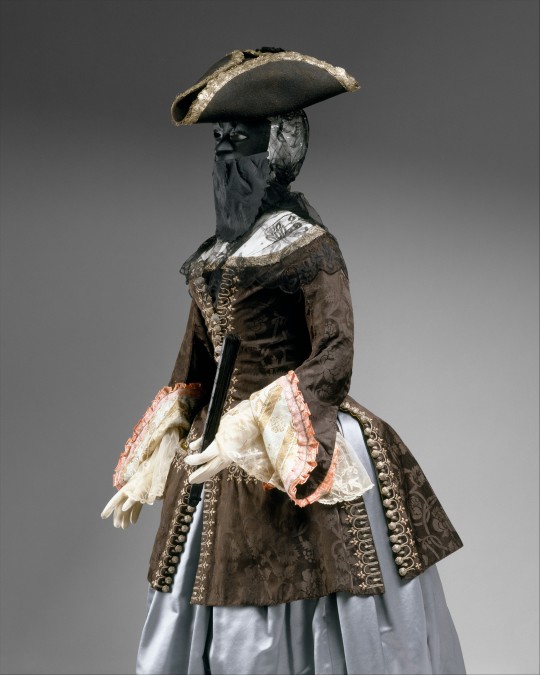
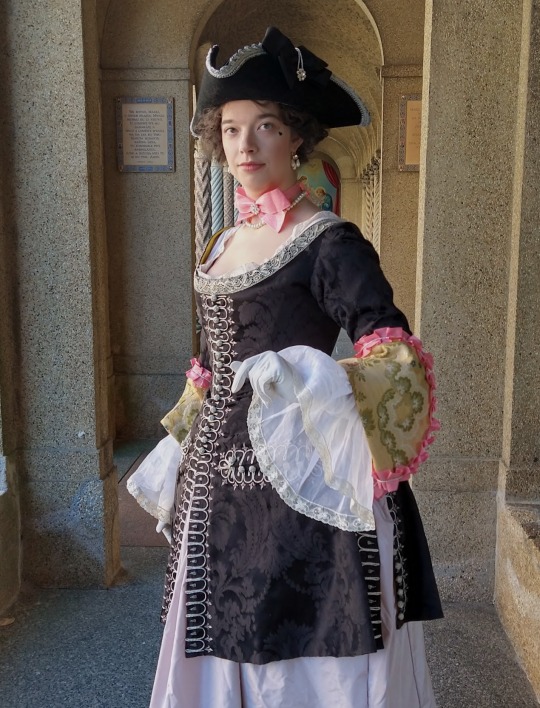
The Met dates it to the 2nd quarter of the 18th century which could be true--but there are several features of this jacket that could easily be dated earlier to the late 17th century, like the button size and layout. I plan to mull over this more in a later post. At least, I would definitely place it in the earlier end of that 1725-1750 range. However, I chose to style it for the 1730s/1740s because it's Fun For Me 🙂!
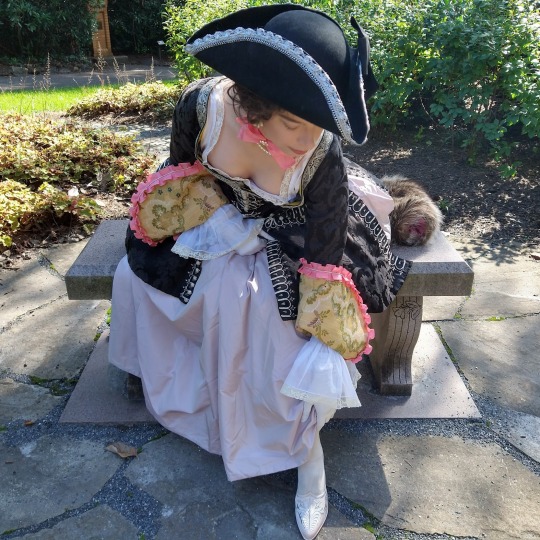
One of the most fun parts was gathering accessories to go with the jacket! I steamed a wool hat blank into the tricorn shape and applied the silver trim, made some detachable undersleeves based on paintings by Pietro Longhi, and threw together a matching neck ribbon as if I was some kind of ornamental poodle
#historical costuming#hand sewing#18th century#clothing reconstruction#riding habit#1720s#1730s#1740s#handsewn
150 notes
·
View notes
Note
!! ducky necklace !!! I love it so much!!! how did you make it/where did you get it? I've been wanting to make or find some replica jewelry...
aah thank you it was so fun to make! I got the gold and lapis filler beads just from Michael's, and the ducks and axes were from two different Etsy shops. Duckies were from NobleBeadsShop. I got the carnelian and black jade duckies because they were pretty, and I didn't feel like taking an extra hour to research what stones would be used in Minoan jewelry (besides lapis i did need that somewhere). The axe heads were from BeadWorldSeattle. I chose them because they reminded me of the double-headed axe/labrys so important in Minoan culture, but in jewelry beads this shape would more likely be intended to emulate papyrus plants instead. As long as it looks good!
I used a toggle clasp to fasten the necklace--no idea if that's historically accurate or not but it's MY favorite necklace fastener. Call it...historically plausible.

The hardest part was turning the duck beads into pendants--the Saffron Goddess duckies are strung through front-to-tail, but my beads were drilled through top-to-bottom.

My solution was to thread head pins through the ducks, anchored with a small gold bead at the bottom, and then use tweezers to roll the top of the pin into an eye that I could thread onto a string. When all assembled, they looked like this:
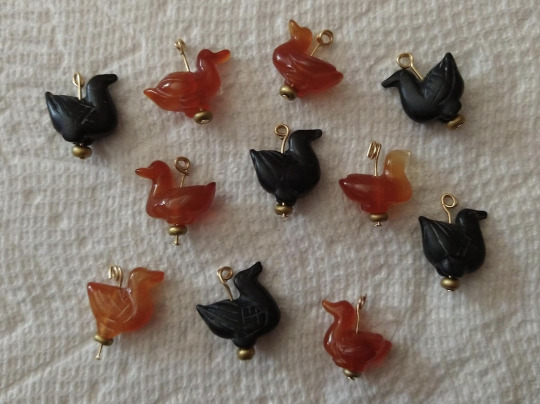
With that done, all that was left was to decide my pattern and string them all together! Oh--and I then went back later and strengthened the knots at the end with a small dab of Beadalon cement to make sure they didn't come loose and fling duckies everywhere :(. I find making jewelry very soothing and only wish I had the opportunity to do more of it, so thank you for giving me the opportunity to talk about my perfect adorable ducky necklace <3
85 notes
·
View notes
Note

hello!! look how nice it lined up, you look like the goddess!
Great screenshot! The saffron goddess fresco is one of my favorites because of how detailed the accessories are. My ducky necklace was inspired by the one she has!
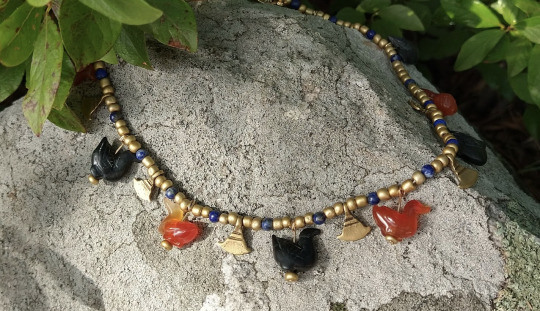
48 notes
·
View notes
Text
Minoan Heanos
The distinctive open-front dresses worn by Minoan women are probably even more iconic than the multi-layered kilts. Over time, there's dispute whether the garment is one piece or a separate bodice and skirt, but currently the one-piece theory is in ascendance.

The word heanos is derived from the Linear B logogram *146, wehanos. The wes- prefix, which is the squiggle in the middle, indicates a garment. Bernice Jones believes that this logogram represents the garment worn by Minoan men and women.
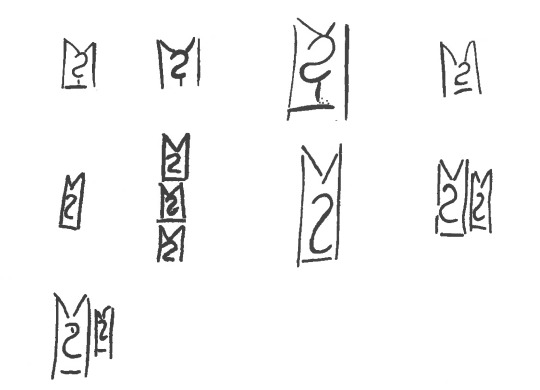
Marie-Louise B. Nosch, The Textile Logograms in the Linear B Tablets, pp 133-138
More research and construction below the cut:
The theory that the garment is a full-length tunic is further supported from imagery from the time, like these figures from the c. 1400 BCE Hagia Triada Sarcophagus. This detail from the sarcophagus shows three figures in some kind of procession, 2 women and 1 man. The woman at left wears a tunic with some kind of pelt as a skirt, and the other 2 figures wear tunics without anything over them, showing that they are one continuous, ankle-length garment.
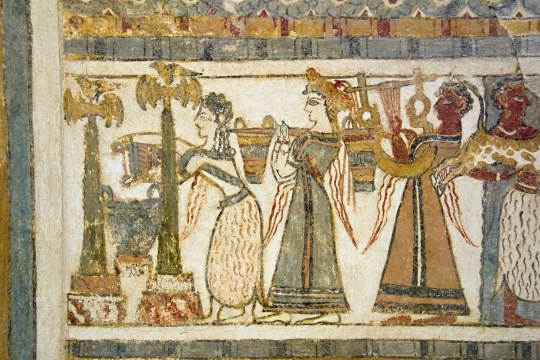
Some of the most important resources for interpreting how the heanos was constructed comes from the two women depicted in the House of the Ladies in Akrotiri, wherein the side seams of the tunic are clearly visible running along the side of the body and under the arm.
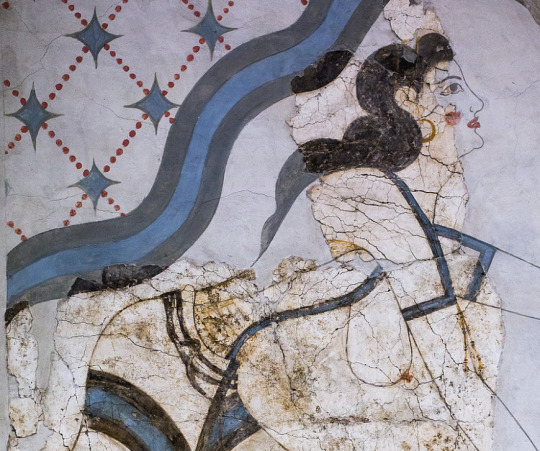
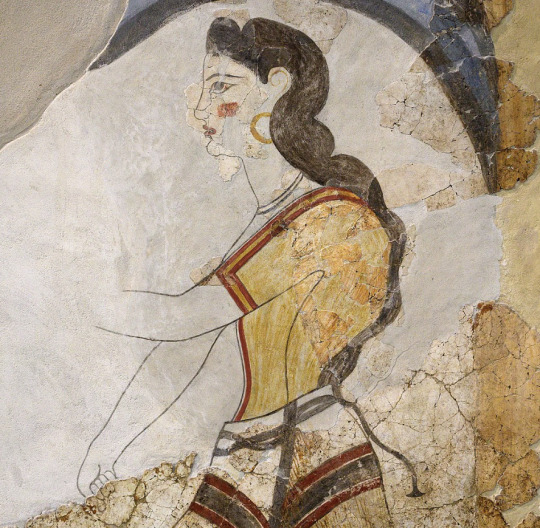
details of figures from the House of the Ladies, Akrotiri, via Wikimedia Commons
advadbsvasb
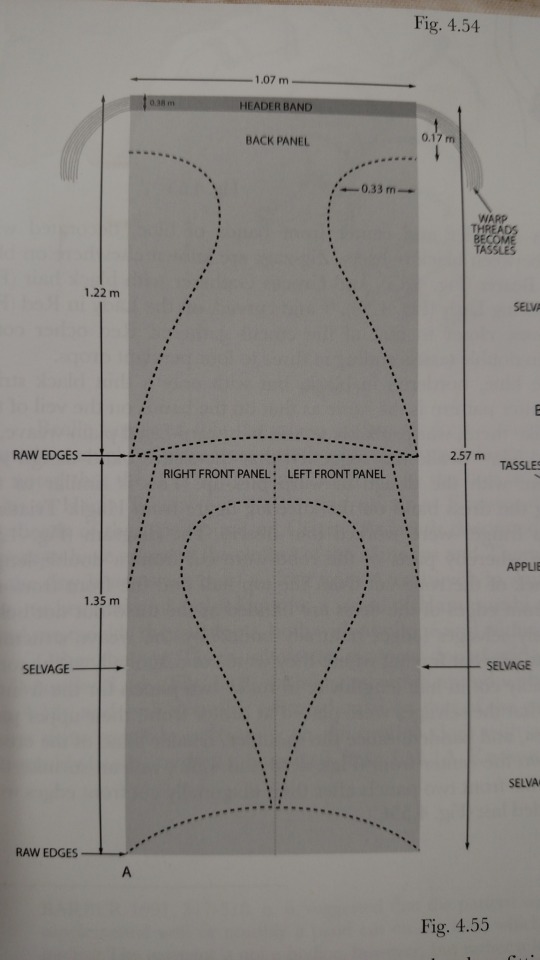

Diagrams from Bernice Jones' book Ariadne's Threads, p. 82, via Gorgeous Tangents
The heanos itself is made of 3 pieces of fabric: 1 back and 2 fronts. These diagrams show a concave hem like on the labrys-shaped kilt but I went with a straight hem, which is an equally valid option. The end of the sleeves are level with the edge of the hem at the widest point. This would probably be the width selvage-to-selvage on the fabric, being narrower than fabric widths commonly are today. There are 4 seams: the shoulder seam, the two side seams, and a front seam (optional, but recommended if you would prefer not being arrested.) It may be tempting to fold the fabric across the shoulder, so the only sewing is side seams and a neck hole, but this makes a weaker garment overall. I used this as a shortcut in my fitting muslin and it caused tears and weak points at the three points of the front opening.

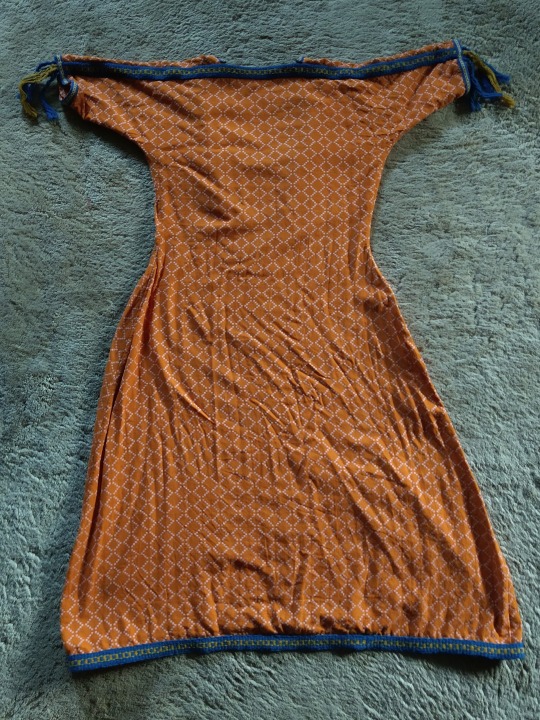
my fabric was a lightweight, moderately loose-woven cotton with a supplementary weave pattern in squares and diamonds. Linen or wool would have been more accurate but also? much harder to find from online quilting stores selling fabric for affordable prices. The main fabric is dark orange and the pattern is made out of pink/lilac threads. This weaving technique resulted in a LOT of long floats (unsecured expenses of thread) on the back--you can see how the wrong side of the fabric is much pinker than the right side. These floats could snag easily if I wasn't careful, so while it made a very effective visual for this tunic, I do not think that this fabric type would be viable for everyday wear. I'll leave it to people who actually know about weaving to ponder what more accurate weaving techniques would be.
Construction
The overall pattern is basically a T-shaped tunic, and the most important measurements are shoulder circumference, shoulder width, bust circumference, and the shoulder-waist length. In addition, you need measurements for the bicep, waist, shoulder-navel length, and hip circumference. After working out the fit with a muslin, I ended up with this pattern, 1 of 4 identical quarters.

Your first impulse may be to make the tunic very close-fitting, since the depictions in frescoes are skin-tight, but since the pattern has no added gusset this is a recipe for Cannot Move Arm. So I gave a very generous curve under the arm, which also made the dress look better when my arms were down, avoiding armpit wrinkles. I continued that ease into about an extra 2 inches added on to my waist measurement and plenty of extra space around my hips so that I could do exciting things like Sit Down.

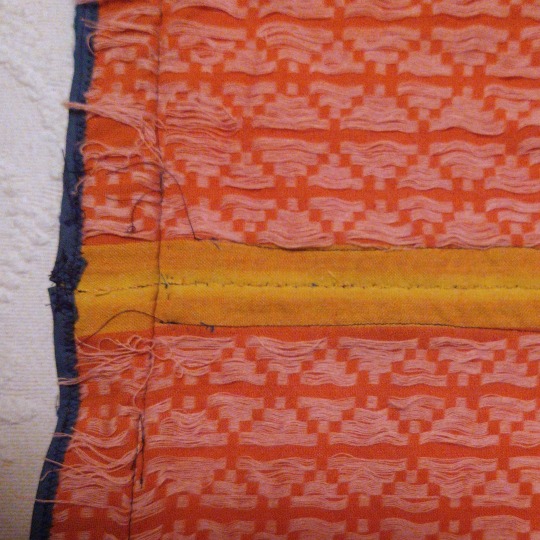
I sewed the shoulder and side seams using the machine, and felled the raw edges on each side of the seam by hand with a whipstitch. I foided back the front edges of the v-neck instead of cutting them, which was a tip I got from the Gorgeous Tangents blog. This strengthens the neckline and keeps it from stretching, and also means that everything can be readjusted if you have size fluctuations or just want to modify the tunic into something more or less modest.
I whipstitched the front edges together by hand--the contrasting selvage didn't matter because it would be covered up by trim. I ended up cutting the tunic a liiiittle shorter than I wanted, so I finished it with some leftover bias binding instead of hemming it to conserve as much length as possible.
Trim
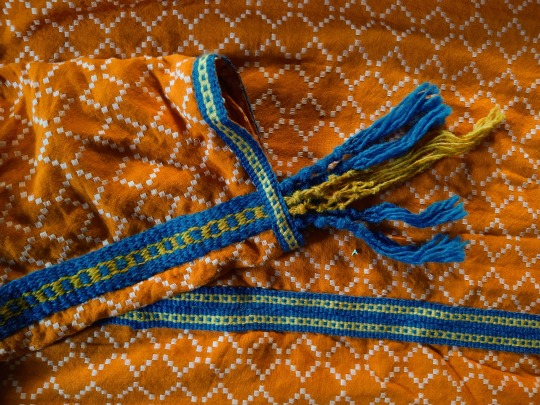
I custom-ordered the woven tape trim from Long Creek Mercantile. Both are made of wool--the "header band" and the hem trim are 1 1/4" wide and the center-front and cuff trim are 3/8" wide. I observed that most images of the Minoan heanos show trim with two colors at most, in a simple geometric or linear pattern, so I consciously restrained myself from ordering anything more elaborate. The clothing on Minoan frescoes is characterized by strongly contrasting colors, so blue trim was the most obvious, and best-looking option. Orange tunics with blue trim appear multiple time in art like the "Dancing Lady" fresco from Knossos:
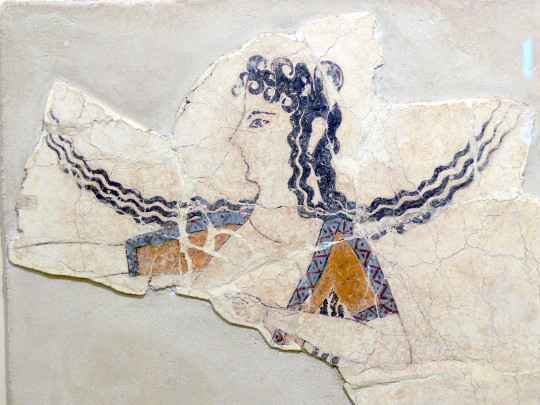
Dr. Jones suggests that the band across the shoulder would historically have been a header band--a band of threads woven at the beginning of a project in order to properly space the warp bands (see her diagram at the beginning). That may be a reason why the shoulder trim often depicted under the front or sleeve trim, as shown above. Regardless, the trim almost always coordinates.
I sewed on the shoulder trim by hand, the sleeve and hem trim by machine, and the center-front trim with a combination of both.
Tassels
Many frescoes from Akrotiri and Hagia Triada show the ends of the supposed header band turned into tassels. This embellishment is not universal among heanoi, as you can see from the "Dancing Lady" above, but it does add a fun little something!
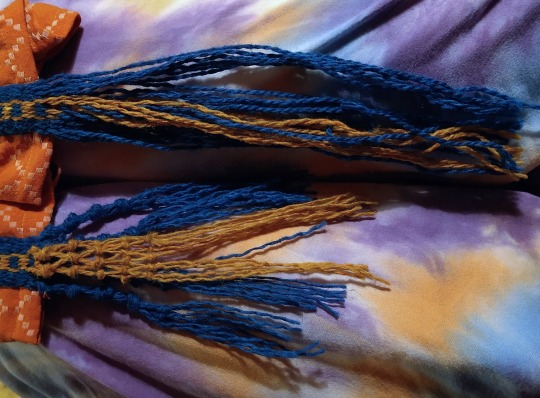
(yes, my Lounging Pants are very fashionable)
I turned the excess ends of the shoulder "header band" trim into fringes, knotting the yellow ones into a lattice and turning the blue yarns into tassels. The lattice-tassel appears on a fresco from Hagia Triada:
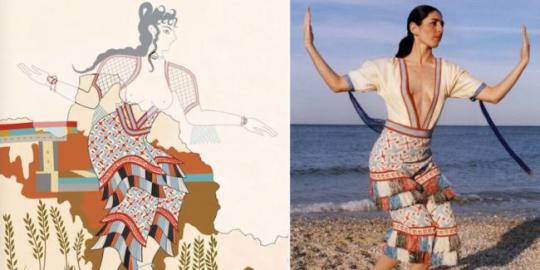
Reproduction of fragmentary fresco from Room 14 at Hagia Triada, Crete
The saffron gatherers from Akrotiri shown below have clearly displayed fringes at the ends of their sleeves. The one on the left has red fringes that appear knotted or ravelled/unravelled in an undulating pattern, and the one on the right has fringes that may be either beaded with papyrus-shaped leaves or cut into short tassels.
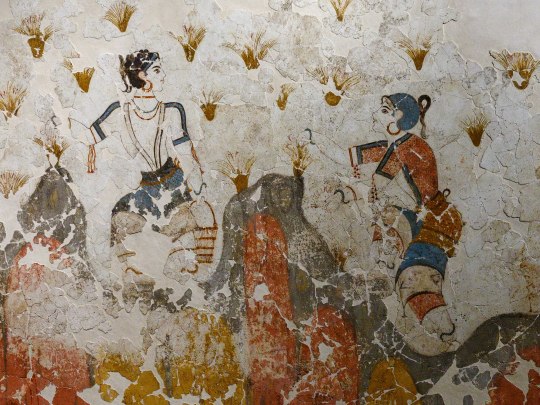
Another option is leaving the fringes loose, as seen in the Akrotiri frescoes from Xeste, room 3:
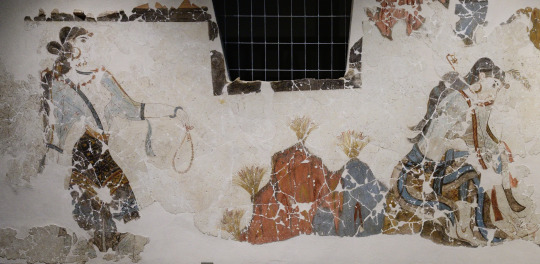
The final garment was super comfy, actually! It's much simpler to create than I thought it would be based on the frescoes, which made it all feel pretty magical when everything came together. I did think it was a little unusual how tailored this garment is, and the potential waste of fabric that comes from a shaped garment, especially compared to how later ancient greek clothing was mainly rectangles. I don't know enough about bronze-age and earlier clothing to have any idea how typical this was, since I'm extremely Not an expert on this subject, but am always open to learning more!
528 notes
·
View notes
Text
Minoan Kilt
The large, structural skirt worn by Minoan women in art is instantly recognizable, and when I made my own I combined current best guesses with my own personal tastes.

My kilt shape follows the hypothesis laid out by Bernice Jones in her book Ariadne's Threads: The Construction and Significance of Clothes in the Aegean Bronze Age. She describes the shape of that of a labrys, a double-headed axe with apparent ceremonial significance in Ancient Minoan culture. This garment may be depicted in Linear-B logogram *166 + we, we-being the backwards-s-shaped squiggle in the center which identifies the piece as a garment.

See pages 336 and 341 in Marie-Louise B. Nosch, The Textile Logograms in the Linear B Tablets
Actual details on construction and materials below the cut:
Construction:
The top and bottom edges of the kilt are concave, so the sides are longer than the middle. This gives the chevron-shape seen on layered kilts in art. In addition, the curved top half makes the skirt flare out, accommodating the hips and giving more freedom of movement to the legs. My kilt measured from my waist to my anklebone at the longest point, and about 1.5 times around my waist.
I chose to make a flounced kilt, with smaller strips of fabric and trim applied to a large base piece, rather than a tiered kilt, in which multiple kilt shapes of varying length are layered one on top of the other, so you end up wrangling 3 layers of fabric around the waist. The flounced kilt saves fabric and gives you a lot more freedom with whatever trim you might want. Jones' diagram for a flounced kilt is seen below:

Unlike the version in the diagram above, I chose not to attach ties to the garment itself both because the linen I used was very heavy and I was concerned about weight, and also because folding the skirt and securing it with a separate tie worked just fine for my tastes. In total I had four flounces: 2 alternating rows each of fabric and fringe.
The vertical edges of most kilts are left plain, probably representing either the selvage or an edge otherwise finished off to prevent fraying. For my kilt, however, I ended up with a couple inches of self-fringe on either side as I adjusted the fabric to the correct width. At least three examples of kilts with fringed vertical edges are known, all three from the so-called "House of the Ladies" in Akrotiri
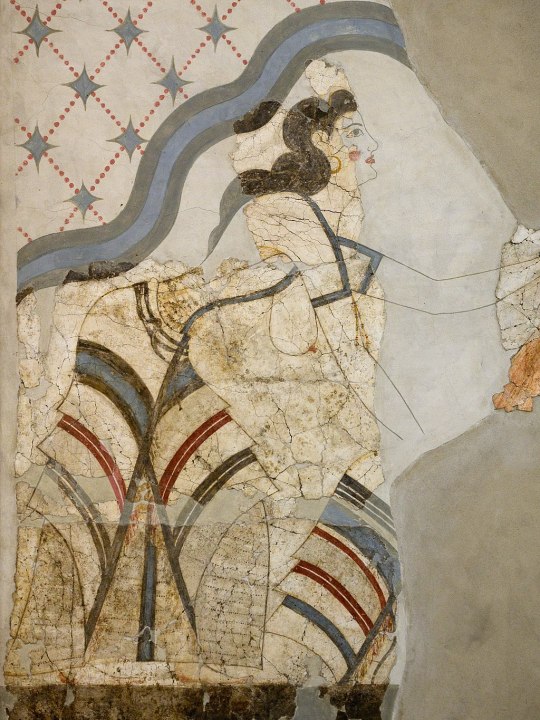
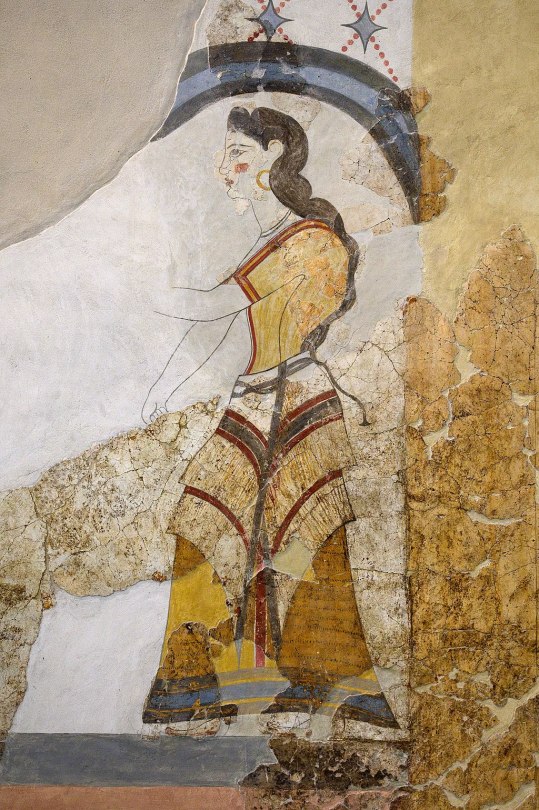
Photos from Wikimedia Commons. Image 1. Image 2.
The vertical edges of these kilts are reinforced with a colored band or tape, probably to keep the garment from unintentional further fraying. Accordingly, I did the same on my kilt. I also like that it gave a nice vertical diagonal to counterbalance the horizontal ones.
Materials
I tried to use mainly linen and wool, the fibers most available on Ancient Crete, but some of my trim was cotton because sometimes you just have to use what's cheap and available in the today times.
The base of my kilt is a heavy, patterned linen in what's called a diaper weave, meaning that a repeating diamond pattern is woven into the pattern itself. A lot of the Minoan textiles depicted in frescoes are characterized by repeating geometric patterns, likely woven into the fabric itself, and that was something I wanted to capture in my own piece. My linen is woven with both cream and natural colored threads. The heavy weight is important to give structure to the garment--otherwise it would be kind of limp. My linen was from Burnley & Trowbridge (shameless plug), as was the plain cotton twill tape I used to bind the top and bottom edges of the kilt, and the dark red wool twill tape I used along the vertical edges.

I bought my cotton fringe from a rug supply store. I had to search a while to find a fringe that would work for me, and I ultimately chose fringes with a woven header rather than the more common knotted one, so that it would lay flat against the kilt. I hid the woven header under a layer of cotton fringed trim from Michaels (yes, Michaels) with this really great diamond and dots pattern woven in black.
The blue layers are from a bolt of vintage wool Kimono fabric. Blue appears frequently in frescoes, likely achieved with indigo or woad dye, or even murex/mollusk dye. The fabric is printed with an imitation ikat pattern of diamonds and squares that made me think "the vibes seem right!" because quite frankly, you aren't going to get "historically accurate" Minoan textiles (which there probably isn't enough archaeological evidence to definitively describe) without, like, hand-weaving it yourself or paying someone hundreds of dollars to do it for you (and that price is if the weaver really likes you). Neither of which appealed to my desire to just make a fun, low stress project. Good enough is good enough.
The narrow trim on the bottom of the blue flounces is vintage cotton/poly woven trim. This trim, while narrow, was quite thick and stiff, which was great because it added more weight and structure to the end of my flounces since the wool fabric itself was quite thin.
The top layer is a custom tablet-woven wool trim that I commissioned from MAHTAVAhandicraft on Etsy. I imagined this as the "centerpiece" of my kilt, and I'd arrange everything to complement it.
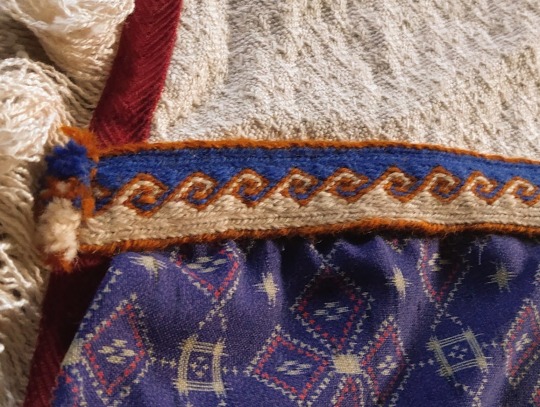
It's a kivrim pattern, which has itself only been traced to 19th-century Anatolia, but I didn't care. The way it looks like waves reminded me of how central the sea was to life in the Ancient Aegean and Mediterranean and it captured the idea and aesthetic I was pursuing. I mean, doesn't it remind you of these dolphins?
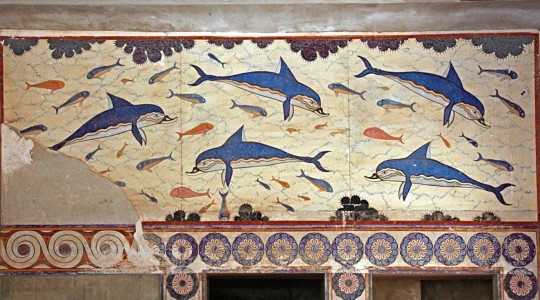
(I like the dolphins)
The whole thing was machine sewn with the exception of hemming and adding trim to the blue flounces. If you were to look at it from the back, you'd see lots of zigzag stitches, because i wanted to be fast! and have fun! not chase some unreachable ideal of "accurate."
As for wearing it, I chose to wear it with the top part folded/rolled down over a belt, so I have a thick tube of fabric around my waist. Many images, like the frescoes above of women with fringed kilts, appear to just show the kilt being tied closed. Other images are so fragmented or stylized that it's unclear what kind of skirt closure was used. Sculptures and figurines definitely show some kind of SOMETHING around the waist, whether this is folded fabric or a kind of belt is unclear. Different art could show different things!
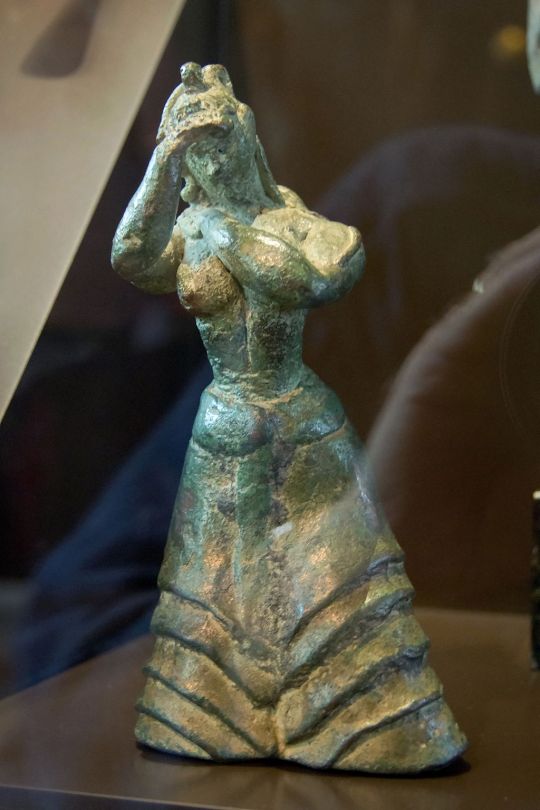
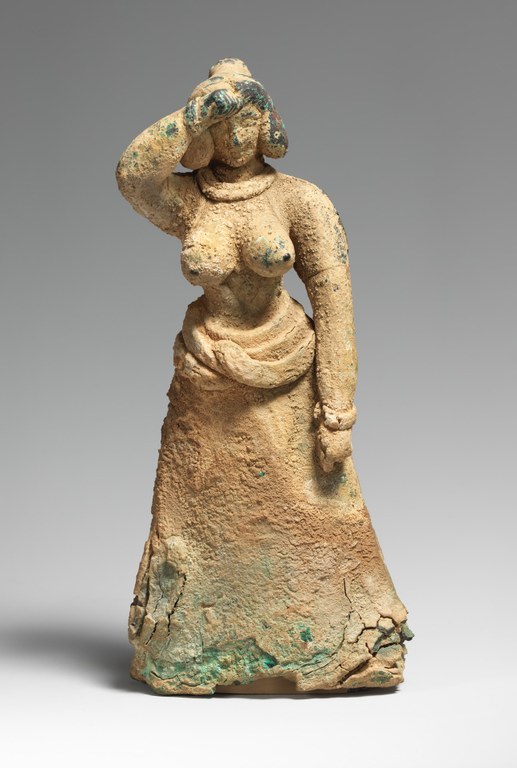
I think I see evidence of a continuous line from the skirt to the waist-roll on the figure on the left, found in Troas, which I think indicates some kind of skirt-folding situation. The woman on the right, found in Crete, looks more like she's wearing some kind of long coiled belt, or perhaps snakes. Who knows? I don't! For my own part, I found the combination of rolled waist + tie belt the most secure for doing things like kneeling, stomping around, and wading into rivers to rescue bees. I also liked that it gave me the bulk around the hips that gives Minoan figurines such a powerful silhouette, and proportionally gives more of an hourglass shape. If you wanted to do something more firmly grounded in the sources, stick just with the waist tie or belt, wrapped around a couple times and tied in back. If you want to be like me, just say "well we don't KNOW it didn't happen" and just do whatever you want. Have fun! Whatever happens, it should be fairly easy to move around in the kilt--this is not a restrictive garment, just a heavy one.
893 notes
·
View notes
Note
Hello! I was wondering what the upper part of your Minoan costume is called- the orange garment.
Also- I have to say that the costume looks absolutely gorgeous!! The video of putting on the wrap skirt is especially cool- it's interesting to see how the clothes fall as you move.
Thank you, and have a good day! :)
Thanks for writing in! Sorry about the wait, I decided to overexplain instead of just telling you. Bernice Jones, the most prolific scholar on ancient Minoan and Mycenaean fashions, has called this garment a heanos, identifying it as Linear-B logogram *146
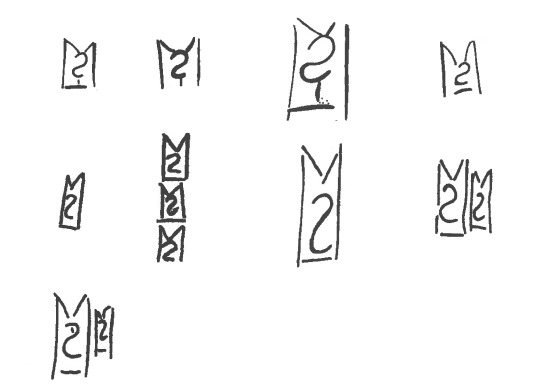
mmmm, crunchy crunchy PDF
The squiggle in the center is the we- syllable, used to indicate a garment. This logogram is called we-a2-no/wehanos, which became the Ancient Greek ἑανός meaning a robe, which is latinized into heanos. You may or may not care about that etymology, but I thought it was neat!
However, I think that just calling it a dress or shift or tunic is absolutely acceptable when speaking in a modern context to people who would prefer not to wade into Linear-B.
I'm almost finished working on a post about my wrap skirt, and once that's published I'll start working on a post about my heanos, promise <3
21 notes
·
View notes
Text
How I accessorized my Minoan costume. For the jewelry, my main priority was to have fun with it! I played around with different bead layouts, shapes, and lengths, loosely based on what I'd already seen from art and artifacts. The ducky necklace is one of my favorite things I've made in a while!
133 notes
·
View notes
Text
How to put on a Minoan wrap skirt! It's...pretty straightforward. If you can wear a towel, you can wear this! You can just tie the belt without rolling down the top (or just roll without the belt) but I think this gives more security and the added bulk around the hips matches Minoan figurines and makes the waist look smaller proportionally. Most of our remaining frescoes are from Thera and therefore may or may not be representative of how these garments were worn in the rest of the Minoan hegemony.
Eventually I'll put together some more in-depth posts but I do have a full time job so it'll take a little while. I'll be posting another video soon showing my accessorizing!
262 notes
·
View notes
Text

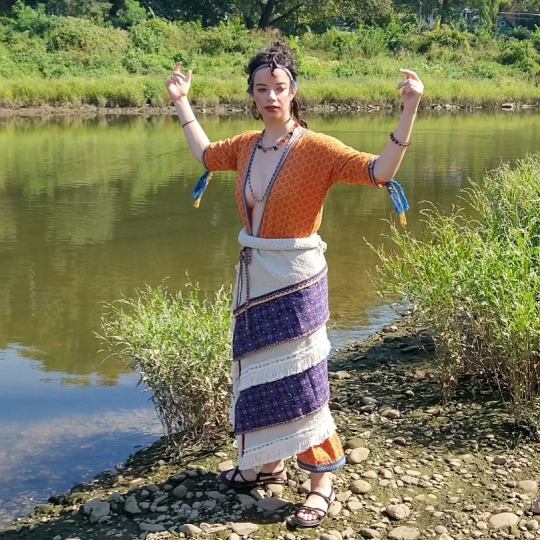

My most recent make is this ancient Minoan ensemble! It consists of a tunic (heanos) worn under a flounced wraparound skirt shaped like a double-bladed axe (labrys). Despite how heavy the linen skirt is, the entire outfit is surprisingly easy to move around in. I even waded into the river to rescue a bee!
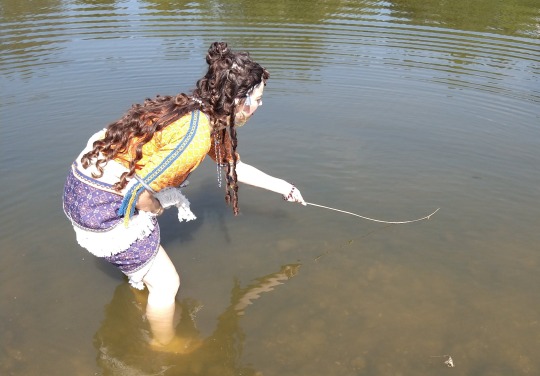
Hot Girl Activities
#minoan crete#minoan#ancient greece#greek mythology#historical costuming#bronze age#my costumes#clothing reconstruction#hot girl summer
6K notes
·
View notes
Text
My naym is catte And wen the ball Is at an ende Or eve'ning fall I haf no tyme To be allure No one can se I monch the fleur
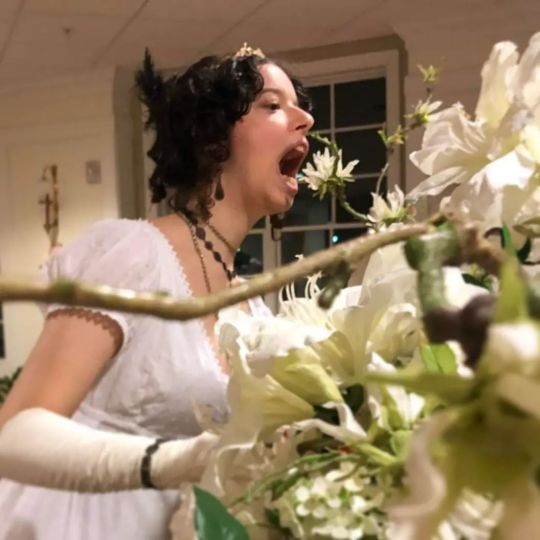
#regency heroine#regency fashion#historical costuming#regency#regency costume#janeite#serious scholarly historical pursuits#tell me im funny
56 notes
·
View notes
Text
A scarlet wool waistcoat and cochineal dye

Bright red is surely one of the most iconic colors of 18th-century fashion. From girls in their cardinal cloaks to British soldiers in their red coats, it is hard to imagine any scene in the American colonies devoid of some touch of this color. The natural world offers several sources of red dye, but cochineal may well have had the most profound effect. The Nahuatl name for cochineal is nocheztli, from nochtli (nopal cactus) and eztli (blood) (Wallert 60). The highest-quality dye came from the domesticated grana fina insect, a cousin of the wild grana silvestre (Marichal 259). By the time of the Spanish conquest, Indigenous peoples in Mexico had spent centuries perfecting the raising and preparation of cochineal insects. Cochineal reached Spain by 1523 and was quickly recognized as a valuable dyestuff for the European market, where quality red was always in high demand (Marichal 256).
The cultivation of cochineal was a way for the Indigenous people of Oaxaca and Mixteca to preserve their own communities and cultures. The tending of the nopal cacti and the cochineal beetles was labor-intensive, best-suited for communal or backyard plots tended by family members (Baskes 192-193). This production did not lend itself to economies of scale—only in the 18th century did large haciendas emerge producing cochineal, and even then this was a miniscule proportion of the total supply compared to the cochineal produced by small-scale Indigenous growers (Donkin 28). This enabled much of the land in Oaxaca to remain in native hands, and Oaxacans defended these land rights greatly. One suit, brought by Indigenous cofraidas against the Dominicans of San Hipolito Martir over ownership of two sitios, lasted almost the entire 18th century (Hamnett 55). Indigenous cochineal growers could safeguard their own customs and ways of life to an extent because cochineal production could not be easily appropriated by colonizers.
Cochineal was produced within the repartimiento system, in which growers would be offered credit Current scholarship indicates that the colonial Spanish repartimiento de bienes (not to be confused with the practice of drafting Indigenous labor for colonial projects called the repartimiento de indios) was not the exploitative system that earlier scholars assumed, but made credit available to a population who otherwise would not be able to access it.The average loan was 9 pesos in exchange for 6 future pounds of cochineal insects, a rate of 1.5 pesos per pound regardless of the market price (Baskes 204-205). The loan contained no additional interest beyond the advance price, which was below market rate (Baskes 197). If the price of cochineal was particularly high one harvest, however, some growers might sell the entirety at market at a higher price and claim that all the insects had been “lost” in inclement weather and could not be used to repay the loan (Baskes 201). Collecting the owed cochineal could be difficult for Spanish officials—Indigenous growers just had to outlast the alcalde’s usual 5-year term and the debt obligation would likely be forgotten (Baskes 195).
Production of cochineal for the European market enabled Indigenous producers to preserve their communities and culture, but this also came at the expense of greater ties between different communities. Because of the labor demands caused by increased cochineal cultivation under Spanish rule, people tended to stay close to their own households, strengthening the bonds within individual villages at the expense of intercommunal ties with other areas (de Ávila B 95).
Any monoculture will have its pitfalls, and one of the drawbacks of cochineal production during the colonial era was the decline of food production. Before the Spanish conquest, inhabitants of the Mixteca Alta used terracing to grow food along the hill- and mountain-sides (Rodriguez 345). Afterwards, a combination of depopulation and altered land use caused many of these formerly fruitful terraces to fall into disrepair. Farmers focused on cochineal production and grazing livestock, the latter of which contributed to erosion of these terraces (Rodriguez 345-346). The cultivation of cochineal at the expense of food production was noted as early as 1579 (Donkin 29). Cochineal production represented the preservation of some forms of local knowledge, but the marginalization of others like how to coax food out of the hilly terrain.
Europeans were very reluctant to recognize the centuries of expertise that Indigenous Mexicans had developed to perfect their cultivation of cochineal. One Spanish writer in about 1600 even claimed that the Indigenous Oaxacans had to be taught how to produce cochineal by Dominican missionaries (Donkin 23)—nevermind that those missionaries had initially tried to encourage Oaxacans to cultivate silkworms instead of their traditional cochineal (Greenfield 92). Europeans also regarded the domesticated grana fina insects as a sort of divine providence, a gift from nature enabling them specifically to make more vibrant reds than they had ever known in the Old World (Greenfield 85). The reality that native inhabitants of Mexico had spent centuries improving cochineal insects to produce better dye than their wild counterparts went unacknowledged.
There was also debate for over a century about what exactly cochineal was. Consultation of such sources as the Bible and microscopes were largely inconclusive. The Spanish had finally determined that cochineal was an insect by the end of the 16th century, but the rest of Europe remained skeptical (Greenfield 132). Ultimately in the early 18th century, Europeans were finally able to conclude that cochineal was in fact an insect after a group of gentlemen collected the testimony of local Oaxacan growers (Greenfield 161). Apparently, the knowledge of Indigenous cultivators could finally be recognized once all other options were exhausted.
Europeans enthusiastically used cochineal dye to enhance their own fashions, but restricted the ability of Indigenous peoples, as well as other non-white inhabitants of New Spain, to profit from cochineal outside of the repartimiento credit system. Regulations in New Spain issued in the 1560s and 70s restricted the dying of cochineal to high-quality cloth, done only by Spanish artisans (Donkin 28). In 1580, the viceroy banned Black and mixed-Black vendors from trading cochineal, and allowed Indigenous Mexicans to sell cochineal only if they were the servants of a Spaniard (Greenfield 103). Cochineal was valuable as a European luxury item, and as such non-white people could be allowed to be visible only as representations of subservience.
The production of cochineal into the 19th century, particularly in Oaxaca, was inextricable from Indigenous ownership and land use. This persistence and protection of traditions in the face of colonial exploitation can still be seen in the woven and embroidered textiles produced by Indigenous Mexican artisan. Today, Indigenous crafters from Oaxaca and elsewhere in Mexico have to fight for their artistry to be recognized as their own, unique expressions of culture and heritage. The designs of Mixe, Chinanteco, and Zapotec weavers and embroiderers have been plagiarized by major fashion labels like Zara and Carolina Herrera (Fuentez López). This constant appropriation by clothing brands represents a continuation of a centuries-long practice of Western fashion being dependent upon the creativity, innovation, and expertise of Indigenous producers while barring them from greater recognition. Similar to how Indigenous Mexicans were restricted from involvement in the fashionable cochineal industry beyond cultivating the insects, the value of Indigenous production is seen primarily as its ability to be reused or resold for fast fashion.
Works Cited
Wallert, Arie. “The Analysis of Dyestuffs on Historical Textiles from Mexico” in The Unbroken Thread: Conserving the Textile Traditions of Oaxaca. Edited by Kathryn Klein, 57-85. Los Angeles: Getty Conservation Institute, 1997. https://www.getty.edu/publications/resources/virtuallibrary/0892363819.pdf.
de Ávila B, Alejandro. “Threads of Diversity: Oaxaca Textiles in Context” in The Unbroken Thread: Conserving the Textile Traditions of Oaxaca. Edited by Kathryn Klein, 87-151. Los Angeles: Getty Conservation Institute, 1997. https://www.getty.edu/publications/resources/virtuallibrary/0892363819.pdf.
Baskes, Jeremy. “Colonial Institutions and Cross-Cultural Trade: Repartimiento Credit and Indigenous Production of Cochineal in Eighteenth-Century Oaxaca, Mexico.” The Journal of Economic History 65, no. 1 (2005): 186–210. http://www.jstor.org/stable/3875047.
Donkin, R. A. “Spanish Red: An Ethnogeographical Study of Cochineal and the Opuntia Cactus.” Transactions of the American Philosophical Society 67, no. 5 (1977): 1–84. https://doi.org/10.2307/1006195.
Fuentes López, Guadalupe. “En 7 años, 23 marcas plagiaron el diseño autóctono de México, y no hay una sola denuncia: activistas.” June 22, 2019. https://www.sinembargo.mx/22-06-2019/3599883.
Greenfield, Amy Butler. A Perfect Red. New York: HarperCollins Publishers, 2006.
Hamnett, Brian R. “Dye Production, Food Supply, and the Laboring Population of Oaxaca, 1750-1820.” The Hispanic American Historical Review 51, no. 1 (1971): 51–78. https://doi.org/10.2307/2512613.
Marichal, Carlos. “Mexican Cochineal, Local Technologies and the Rise of Global Trade from the Sixteenth to the Nineteenth Centuries” in Global History and New Polycentric Approaches. Edited by Manuel Perez Garcia and Lucio De Sousa, 255-273. Singapore: Palgrave Macmillan, 2018. https://doi.org/10.1007/978-981-10-4053-5
Rodriguez, Veronica Perez, and Kirk C. Anderson. “Terracing in the Mixteca Alta, Mexico: Cycles of Resilience of an Ancient Land-Use Strategy.” Human Ecology 41, no. 3 (2013): 335–49. http://www.jstor.org/stable/24013746.
Further Reading
Villanueva, Margaret A. “From Calpixqui to Corregidor: Appropriation of Women’s Cotton Textile Production in Early Colonial Mexico.” Latin American Perspectives 12, no. 1 (1985): 17–40. http://www.jstor.org/stable/2633560.
Kellman, Jordan. “Nature, networks, and expert testimony in the colonial Atlantic: The case of cochineal.” Atlantic Studies 7, no. 4 (2010) 373-395, https://doi.org/10.1080/14788810.2010.516190
Terrazas Williams, Danielle. "Finer Things: African-Descended Women, Sumptuary Laws, and Governance in Early Spanish America." Journal of Women's History 33, no. 3 (2021): 11-35. http://doi.org/10.1353/jowh.2021.0033.
#colonial history#colonial mexico#fashion history#Costume History#historical costuming#cochineal#dyeing#clothing history#long post
35 notes
·
View notes
Text
Muskrat fur cuffs and the North American fur trade
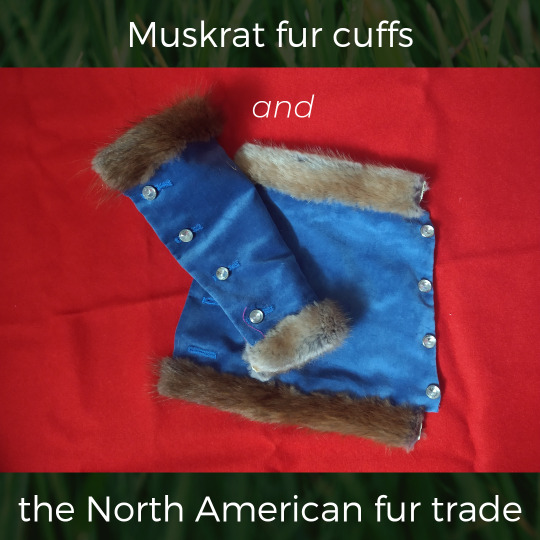
In this post, I am focusing my research on the fur trade up to the mid 18th century. On a superficial level, this is because the armlets in question are based on a 1732-35 painting. But, more importantly, any attempt to expand beyond this using this format would be far too limited to responsibly grapple with the history. In addition, the end of the French and Indian wars in 1763 resulted in changing fur trade dynamics which would not be easily integrated into the research I have been able to do. There are many facets I had to leave out like religion, trading posts, and more, simply because a comprehensive history of the fur trade, even before 1763, is a book topic, not an Instagram one. For this post, I chose to focus largely on the material aspect--tangible goods and how they were experienced by Indigenous communities as both suppliers of pelts and consumers of trade items. The latter slides will also look into human relationships and enduring consequences as much as space will allow.
“Indigenous” in this post is a catch-all descriptor that tries to encompass a vast variety of different nations who had varying contacts and concerns within the early fur trade. In the north, Hudson’s Bay Company traded primarily with Cree, Dene, Inuit, and Assiniboine groups (Chan 79). The Great Lakes region was dominated by Anishinaabe groups, including the Ojibwe, Odawa, and Potawatomi (Warren 124). In the Ohio River Valley, trade was largely divided among the Miami, Wyandot, and Shawnee (Sleeper-Smith, Indigenous Prosperity 95). Additional fur trading occurred along the southern British colonies as well, but I did not find scholarship that has covered it to the same extent. The history of the North American fur trade, at least in its earlier decades, challenges the paternalistic idea that Indigenous groups were helpless against the arrival of Europeans and their trade goods, as if European culture was so potent that mere proximity was enough to degrade centuries-old traditions. Rather, Indigenous peoples used their knowledge of the land, access to pelts, and kinship networks to enter into the trade on their own terms and use it to further their own material and cultural ends.
While the fur trade was dominated by beaver pelts, Native American trappers caught and traded a variety of pelts. Muskrat made up a fairly minor part of the overall trade, but still had moments of demand. In the Ohio River Valley, the muskrat fur trade grew as a result of beaver pelt oversupply in the late 17th century. Between 1696 and 1716, indigenous peoples in the valley developed a fur trade that focused on pelts like muskrat, otter, raccoon, and marten. These pelts had become more valuable as trade goods, and more prized in the European market, because of the drop in beaver prices (Indigenous Prosperity 192-194). Further north, the Hudson’s Bay Company acquired an estimated 6000-7000 pelts annually between 1710 and 1725, 15,200 pelts in 1739 and 24,600 pelts in 1750 (Obbard 1015). Notably, this rise towards the middle of the 18th century corresponds to both an overall boom in the fur trade in the 1730s, and a drop in beaver trade by 1750, both factors that would encourage the trapping of muskrat (Carlos 111-112).
European traders were highly sensitive to the material preferences of their counterparts. Indigenous trappers and their families had very specific standards for trade goods. Cloth is the most significant example of this. European textile mills produced cloth specifically for Native consumers, with close attention to color, pattern, and weight (Levine). The importance of cloth also highlights the extent to which the European goods provided in the trade shifted fairly quickly from utilitarian goods to luxury items. Silver, for instance, was in such high demand even as early as the late 17th century that it actually endangered the currency supply in New France as French traders sought to melt down silver coins into tradeable items (Indigenous Prosperity 193). For Indigenous artisans, especially women, this influx of luxury European goods offered opportunities to enhance their own artistry. Native women used cloth and its attendant sewing implements, beads and trim, to create elaborate beadwork and patterns on clothing, creating exquisite wearable artwork with deeply meaningful expressions of their own cultures (Indigenous Prosperity 175). Indigenous relationships with European trade goods were highly transformative. Even old kettles were taken apart and transformed into jewelry and other items of personal adornment. Indigenous consumers readily adapted trade goods into their own cultures, rather than performing a simple 1:1 replacement of traditional goods and ways of life for European ones.
In 1852, William Whipple Warren wrote a history of the Ojibwe, his mother’s people, based on oral histories he collected. The accounts in this history accord with a general impression that the fur trade in the 17th and 18th centuries was actively managed by and productive for the indigenous participants, rather than reducing Native peoples to mere clients of European trading houses. The book includes several anecdotes that depict the fur trade as a way for the Ojibwe to further their own personal and national goals, especially in relation to other Indigenous groups. One story recounts an Ojibwe hunter who, after his family was massacred by enemy O-dug-am-ee (Fox/Meskwaki), trapped for pelts until he had enough to convince the French to help him get revenge (Warren 153). In instances like this, European traders were used as tools by indigenous operators rather than the other way around. The Ojibwe also used the fur trade for their own territorial ends. Through trade, they acquired weapons with which to fight against the Dakota/Santee Sioux, pushing them out of favorable grounds (Warren 160, 178). The Ojibwe thus gained yet more opportunities to trap valuable pelts for the fur trade (Warren 126-127). In this instance, as in many others, the fur trade with Europeans had markedly different effects on different Indigenous nations.
The histories also specifically highlight the difference between French and English traders, praising the French for their respect of Ojibwe customs and integration into Ojibwe communities, which later English and American settlers bypassed in favor of assimilation and domination (Warren 132). Successful integration into Native communities and kinship networks was crucial for the success of early European fur traders. For one thing, European traders were largely dependent on Indigenous communities to provide them with food (Sleeper-Smith, Women Kin & Catholicism 429). Indigenous women in particular attained importance for their role in agricultural production and through their ability to create profitable trade relationships for both sides through marriage (Women Kin & Catholicism 430). Warren’s history gives an example of the centrality of women in the fur trade when he mentions the Ojibwe wife of French trader Jean Baptiste Cadotte, who was notable for the influence she could sway over her extended family (Warren 213). The influence from these kinship networks enabled Cadotte to convince the Ojibwe of Lake Superior to stay out of Pontiac’s rebellion, keeping them from being destroyed like some other tribes that had gotten involved in European wars (Warren 211).
An overview of this trade, no matter how general, still has to acknowledge the enduring negative consequences that have been wrought by the presence and encroachment of white colonists into Indigenous spaces. The North American fur trade evolved into something much more exploitative with the European occupation of Indigenous peoples’ traditional territories and the proliferation of unfair treaties. For instance, the accounts of the early fur trade in Warren’s oral history of the Ojibwe were colored by the tellers’ awareness of the negative impact that contact with European settlers had ultimately caused by the 19th century. Guns and alcohol are singled out as the most significant trade goods, reflecting the compounding detrimental effect that these items had Native populations in later decades (Warren 119). In addition, even benign contact with European groups carried exposure to devastating diseases like smallpox. The disruptions caused to Indigenous communities by disease, warfare, and European settlement affected traditional supplies and made them more reliant on a fur trade that was increasingly stacked against indigenous traders.
A 1972 documentary called “The Other Side of the Ledger: An Indian View of the Hudson's Bay Company” describes how the Hudson Bay Company exploited Indigenous fur traders into the modern day. The company traded for furs on unequal terms, and Indigenous trappers were unable to try to trade elsewhere for more favorable terms because for many remote communities, the Hudson Bay Company stores were the only nearby sources of food. These supplies were sold at high mark-ups, forcing customers to buy on credit. This crediting system kept Indigenous communities in perpetual debt to the Hudson Bay Company, as their principal provider of food and buyer of pelts. The particular involvement of the Hudson Bay Company in operating these stores ended in 1987 (Gismondi), but even today food insecurity remains high among Native families living on reservations, owing to limited and expensive groceries and low incomes. The early years of the fur trade held promise as a zone of cultural and economic exchange in which Indigenous participants were often equal, at times dominant, partners in trade. Nevertheless, contact with European traders initiated a perpetual drive for settlement, territorial expansion, and the attendant marginalization of Native peoples in their own lands by European colonizers.
Works Cited:
Carlos, Ann M., and Frank D. Lewis. Commerce by a Frozen Sea: Native Americans and the European Fur Trade. University of Pennsylvania Press, 2010. http://www.jstor.org/stable/j.ctt3fhbsp.
DeFalco, Martin and Willie Dunn, dir. The Other Side of the Ledger: An Indian View of the Hudson’s Bay Company. 1972; National Film Board of Canada. https://www.nfb.ca/film/other_side_of_the_ledger/.
Gismondi, Melissa. “The untold story of the Hudson’s Bay Company.” Canadian Geographic.May 2, 2020. https://www.canadiangeographic.ca/article/untold-story-hudsons-bay-company.
Levine, Mary Ann. “The Fabric of Empire in a Native World: An Analysis of Trade Cloth Recovered from Eighteenth-Century Otstonwakin.” American Antiquity 85, no. 1 (2020): 51–71. doi:10.1017/aaq.2019.81.
Obbard, Martyn E. et. al, “Furbearer Harvests in North America.” 1987. In Wild Furbearer Management and Conservation in North America, edited by M. Novak, J.A. Baker, M.E. Obbard, B. Malloch, 1007-1034. Ontario Ministry of Natural Resources, 1999. https://www.researchgate.net/publication/275353911_Furbearer_Harvests_in_North_America_1600-1984
Sleeper-Smith, Susan. Indigenous Prosperity and American Conquest: Indian Women of the Ohio River Valley, 1690-1792. Chapel Hill: University of North Carolina Press, 2018. Accessed August 11, 2021. http://www.jstor.org/stable/10.5149/9781469640600_sleeper-smith.
Sleeper-Smith, Susan. "Women, Kin, and Catholicism: New Perspectives on the Fur Trade." Ethnohistory 47, no. 2 (Spring, 2000): 423-452.
Smith, David Chan. "The Hudson's Bay Company, Social Legitimacy, and the Political Economy of Eighteenth-Century Empire." The William and Mary Quarterly 75, no. 1 (2018): 71-108. doi:10.5309/willmaryquar.75.1.0071.
Warren, William Whipple. History of the Ojibways: Based upon Traditions and Oral Statements. Saint Paul, Minn.: Minnesota Historical Society, 1885. https://www.loc.gov/item/rc01001074/.
Further Reading
Allard, Amélie. “Relationships and the Creation of Colonial Landscapes in the Eighteenth-Century Fur Trade.” American Indian Quarterly 44 (2020): 149–70. doi:10.5250/amerindiquar.44.2.0149.
Nassaney, Michael S. "Decolonizing Archaeological Theory at Fort St. Joseph, An Eighteenth-Century Multi-Ethnic Community in the Western Great Lakes Region." Midcontinental Journal of Archaeology 37, no. 1 (2012): 5-23. http://www.jstor.org/stable/24571259.
Snow, Deborah. "Impact of the French Fur Trade on the Lives of Native Women in the Great Lakes Region during the Seventeenth, Eighteenth, and Nineteenth Centuries." Order No. EP77052, University of Michigan-Flint, 1999.
#long post#fur#colonial history#costume history#fashion history#indigenous history#historical costuming#my costumes
21 notes
·
View notes
Text
A cotton-print dress and Logwood dye

This brown cotton print is a reproduction from a gown in Colonial Williamsburg’s collection (Gown no. 2004-97). While I am still uncertain of whether this dress was originally purple or dyed with logwood, I have chosen that print for this project because:
Some purple dyes from this period have discolored into brown
Logwood dye does brown with age depending on the mordant
Logwood produced a variety of colors including, potentially, this rich brown
Purple is my favorite color and, since it’s a color I like to incorporate into my costumes, I think it’s important to discuss the extent to which European pursuit of this dye contributed to slavery and colonization in central America
Logwood is a type of dyewood used in the 17th and 18th centuries to produce a wide range of dyes, particularly purples and blacks. It was highly sought-after by European nations for their growing textile industries (Newton 16). By Europeans first encountered logwood in the 1550s, when Spaniards waged campaigns against Maya on the Yucatan peninsula (Offen 113). Scholarship largely focuses on British harvesting一British interests in logwood lead to the creation of British Honduras, later Belize. European powers also tried growing logwood elsewhere. The British and French planted logwood in Jamaica, Haiti, and other Caribbean islands, and by the end of the 18th century they had even planted logwood in the Indian and Pacific Oceans (Offen 113). Logwood thus became another product with which colonizers transformed other landscapes for their own profit.
In the 17th century, logwood became a significant component of colonizer economies in the Caribbean. In 1679 in Jamaica, one government paper recorded a sugar export of 7637.75 tons, unsurprisingly the largest export on the table. The second largest export, however, was logwood, at 5119 tons (”Account of Passengers”). Logwood was primarily sold by British “Baymen,” who operated illegally in Spanish Yucutan and Belize. Baymen along the Yucutan Peninsula and Bay of Honduras lead a marginal existence. They relied on their nearby indigenous allies, the Miskito, to aid in protection (Newton 25). But this was not the only way in which the British used indigenous groups. In order to support their logging, they raided nearby Maya villages, enslaving men, women, and children (Bialuschewski 49). Women were forced to stay in the loggers’ camps, while men and children were exported elsewhere, to places including Jamaica and New York (Bialuschewski 50).
British colonial interests in enslaved Maya waned as the Maya abandoned their nearby villages and the events of King Philip’s war in New England curtailed the market for indigenous slaves overseas (Bialuschewski 49, 51). Nevertheless, the Baymen’s commercial enterprise was still reliant on forced labor. Proximity to British islands in the Caribbean meant that logwood providers along the peninsula and the bay could access a steady stream of enslaved Africans, with Jamaica as the main source (Restall 400). They acquired further enslaved men and women by trading with other merchants, like the Dutch (Newton 29). With an enslaved labor force, exportation of logwood continued to increase. By 1755, Baymen were exporting 13,000 tons of logwood annually (Offen 121-122). By the end of the 18th century, Belize had become a territory wholly dependent on the wood cut by enslaved individuals, who made up ¾ of the total population (Restall 400).
The logging industry’s existence within the Spanish Empire, far from the protection of English imperial forces, continued to be a source of instability. This instability disproportionately fell on the enslaved African men and women forced to harvest the dyewood. British logging settlements were sites of frequent skirmishes with the Spanish. These skirmishes often took the form of raids in which Spanish forces would seize the enslaved men who worked on Baymen’s operations (Restall 389). But the proximity of Spanish settlements also presented opportunity; enslaved individuals could escape to these settlements claiming their desire to convert to Catholicism, thus having themselves declared free in Spanish territory (Restall 391).
The British merchants who profited from enslaved production of marketable logwood also found advantage in pursuing religion. In 1727, a group of Baymen offered to donate logwood to Christ Church in Boston, so that the church could benefit from its sale (Newton 15-16). In thanks, the church council had a lavish pew built for them, right next to the pulpit (Newton 16). Over the next 30 years, more than 80 baymen continued donating logwood to Christ Church, assuring that they retained pride of place in the church’s social hierarchy (Newton 17). Patronage of this church acted as a sort of reputation laundering, in which these merchants, scarcely better than buccaneers, illegally harvesting logwood on the fringes of the Spanish empire, could refashion themselves as respectable British gentlemen. Christ Church was also called Old North Church. That was the same church immortalized in Revolutionary War lore as the sight of the “One if by land, two if by sea” in the journey of Paul Revere. The exploitation of Black and indigenous labor for fashionable dyes therefore has a direct link to one of the most famous popular narratives of the American Revolution.
Logwood presented a unique opportunity for the Thirteen Colonies because it presented a loophole to the resented mercantilist system. Since logwood was harvested outside of the British empire, traders could avoid customs and taxation (Rossano 240). Merchants from New York and New England acted as important middlemen in the logwood trade between the Bay of Honduras and Europe (Newton 19, Rossano 229), and they found the logwood trade to be a convenient source of revenue to offset the cost of desired consumer goods (Rossano 229). Thus, colonial consumers of European imports could still benefit from the exploitation of enslaved labor and disruption of indigenous communities along the Yucatan peninsula, even if they themselves were not directly involved in the logwood trade, or even if they weren’t purchasing logwood-dyed textiles.
Works Cited:
“Account of Passengers, Servants, and Slaves Brought to Jamaica. Port Royal.” (March 25, 1679) in The Calendar of State Papers, Colonial: North America and the West Indies 1574-1739, Vol. 10, ed. W Noel Sainsbury and J W Fortescue (London: Her Majesty's Stationery Office, 1896)
Bialuschewski, Arne. "Slaves of the Buccaneers: Mayas in Captivity in the Second Half of the Seventeenth Century." Ethnohistory 64, no. 1 (2017): 41-63. doi:10.1215/00141801-3688359.
Gown, 1785-1795, The Art Museums of Colonial Williamsburg, object no. 2004-97, https://emuseum.history.org/objects/78119/gown
Newton, Ross A. ""Good and Kind Benefactors": British Longwood Merchants and Boston's Christ Church." Early American Studies 11, no. 1 (2013): 15-36. http://www.jstor.org/stable/23546700.
Offen, Karl H. “British Logwood Extraction from the Mosquitia: The Origin of a Myth.” Hispanic American Historical Review 80, no. 1 (February 2000): 113-135. doi:10.1215/00182168-80-1-113.
Restall, Matthew. “Crossing to Safety? Frontier Flight in Eighteenth-Century Belize and Yucatan.” Hispanic American Historical Review 94, no. 3 (August 2014): 381–419. doi:10.1215/00182168-2694300.
Rossano, Geoffrey L. "Down to the Bay: New York Shippers and the Central American Logwood Trade, 1748-1761." New York History 70, no. 3 (1989): 229-50. http://www.jstor.org/stable/43460260.
Further Reading:
Cromwell, Jesse. “Life on the Margins.” Itinerario 33 (3) (2009): 42–71.
Cromwell, Jesse. "More than Slaves and Sugar: Recent Historiography of the Trans-imperial Caribbean and Its Sinew Populations." History Compass 12.10 (2014): 770-83
Pellizzari, Peter. "Supplying Slavery: Jamaica, North America, and British Intra-imperial Trade, 1752-1769." Slavery & Abolition 41.3 (2020): 528-54.
#costume history#fashion history#logwood#colonial history#historical sewing#historical costuming#my costumes
38 notes
·
View notes
Text
A Pierrot Jacket and the Pursuit of French Fashion in the Americas

I've decided to start a new project in which I take historical pieces I've made, select one element, and expand upon that element's greater historical context...For me, pierrot jackets are the quintessential French style of the late 18th century and I'm based in the US, so I decided to do a reflection on French fashion in the Americas, specifically French colonies, and how it was intertwined with French women's enslavement and control of Black women.
Most of the information in this post is from Karol K. Weaver's "Fashioning Freedom: Slave Seamstresses in the Atlantic World.
What does it mean to wear French fashions in the western hemisphere? Enslavers, planters, and merchants in St. Domingue, both French-born and Creole, pursued French fashion even as the hot climate and the innovations of free women of color created unique styles. Their pursuit of fashion was facilitated by the enslavement of Black men and women, both in the wealth produced by plantations and the labor of enslaved seamstresses.
Like in British colonies, French colonists purchased goods from the mother country, including the means to create fashionable dress. In the March 28, 1768 edition of Les Affiches Americaines , Saint Domingue's newspaper, a tailor named Brohan placed a notice in among the advertisements for plantations and enslaved men and women (vol 12. p100-3). Brohan was fresh from Paris, and he offered dressing gowns, ribbons, hats, thread, and silk, among various other items.
French women attempted to enforce their stylistic supremacy within St. Domingue, even as they appropriated Black fashions, by pressuring officials to restrict the types of dress that free women of color could wear, such as mandating headscarves and forbidding silk (Weaver 51). French fashions became a tool for white colonists to enforce a visual system of inferiority when they felt threatened by the prominence of free women of color.
Some enslavers even sent or brought their enslaved seamstresses to France in order to learn French fashions and methods (Weaver 48). By doing so, French women of the Caribbean actively used their slave-owning status as a way to increase their connection to the French mainland. Their aspirations to French elite status and fashioning was inextricable from their enslavement of Black women.
Enslaved men and women brought to France during the 18th century had the opportunity to sue for freedom when they arrived on French soil (Peabody 6-7). They might also be manumitted, as enslavers attempted to retain their services rather than let them be sent back to the colonies by French officials (Peabody 135). Enslaved seamstresses brought to France could therefore force their own freedom, subverting their mistresses' attempts to enhance their own status as fashionable elite slaveowners.
Enslaved seamstresses and laundresses who remained in French colonies took revenge where they could. A French mistress’s fine wardrobe could be continually marred by torn fabric, missing buttons, and other injuries--the “accidents” from enslaved women’s washing and ironing (Weaver 54). Seamstresses could self-liberate themselves and run away, using their skills to support themselves in urban centers among other free women of color (Weaver 54).
The presence of French fashion in the Americas was coupled with the exploitation of enslaved individuals. French women in the colonial Caribbean sent their enslaved seamstresses to train in cities in the colonies or France itself. Colonial women further used style as a way to mark themselves as a way to mark themselves as superior by reserving certain elements of dress for whites only. Despite this, their pursuit of fashion enabled enslaved seamstresses to assert their own power, either by taking their own freedom or sabotaging their mistresses' clothing.
Works cited:
Les Affiches Americaines 1768, Vol. 12 Page 100-3 University of Florida Digital Collections, https://ufdc.ufl.edu/AA00000449/00004/104j
Peabody, Sue. There Are No Slaves in France: The Political Culture of Race and Slavery in the Ancien Régime. New York: Oxford University Press, Incorporated, 1996.
Weaver, Karol K. "Fashioning Freedom: Slave Seamstresses in the Atlantic World." Journal of Women's History 24, no. 1 (Spring, 2012): 44-59.
Further reading:
Potofsky, A. "Paris-on-the-Atlantic from the Old Regime to the Revolution." French History 25.1 (2011): 89-107
Skeehan, Danielle C. "Caribbean Women, Creole Fashioning, and the Fabric of Black Atlantic Writing." The Eighteenth Century 56, no. 1 (2015): 105-23. http://www.jstor.org/stable/24575132.
#costume history#fashion history#historical costuming#my costumes#colonial history#historical sewing
9 notes
·
View notes